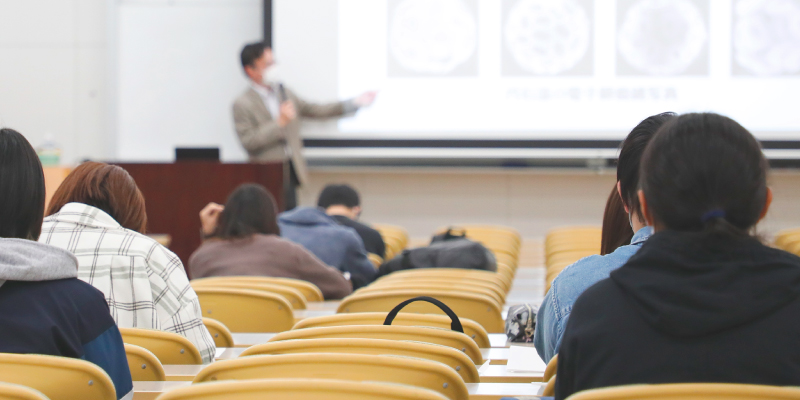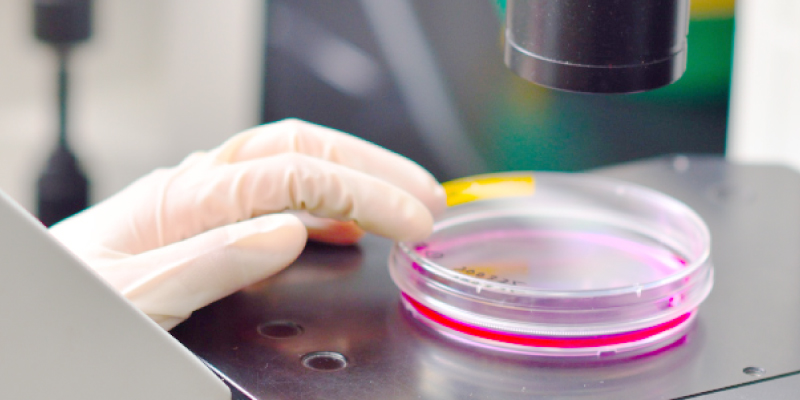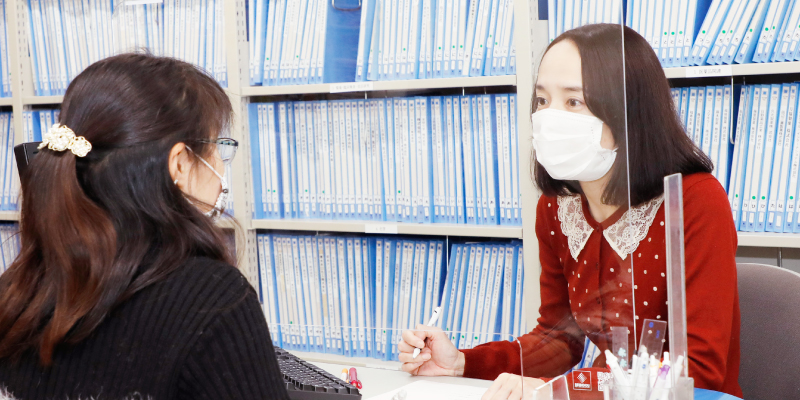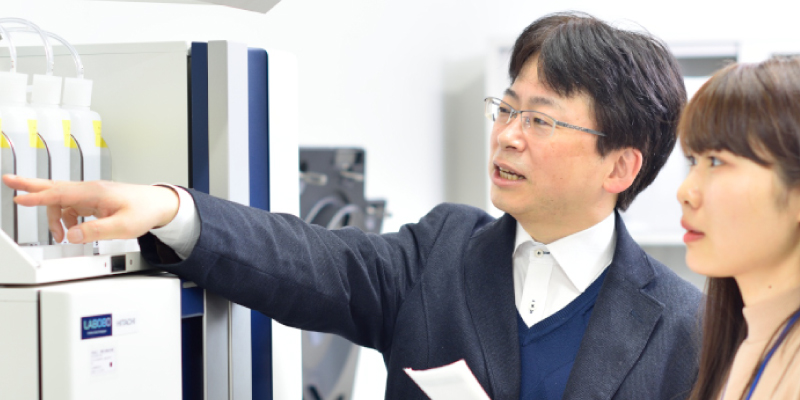
Overview of the Department of Animal Bioscience
The Earth is home to a great variety of animal life. The Department of Animal Bioscience was created in the 2009 academic year with the goal of training students to be able to contribute to humankind, for example by understanding the mechanisms by which animals live, conducting research into health and longevity, elucidating disease, and evaluating the safety of drug discovery and food products.
In addition to studying the latest bioscience developments at the most basic genetic, molecular, and cellular levels, students of the Department develop an ability to understand and research animals in a comprehensive and multifaceted manner by learning about subjects such as individual animals' physiology and behavior, pathology, embryo engineering, and bioethics. They also have the opportunity to interact with experimental animals during lab work, and they learn how to properly manage animals from the standpoint of animal protection and welfare.
By earning credits in the appropriate subjects, students can also earn certification as a food hygiene manager or food hygiene observer, both of which roles concern the assurance of food safety.
Coming face to face with various animals at the Department of Animal Bioscience
In addition to the mouse, which serves as the most important model animal, students of the Department of Animal Bioscience conduct research into a range of animals that most people do not have the opportunity to encounter on a daily basis. Lab work and research using these animals is augmented by off-campus opportunities to study livestock and wild animals. Along with experiments at the individual animal level, students study experiments at the cellular, genetic, and protein levels.
 |
 |
 |
| Mus musclus : Fundamental experiments in animal science, Applied experiments in animal science, Specialized experiments in animal science, Graduation research | Danio rerio : Specialized experiments in animal science | Ciona intestinalis : Graduation research |
 |
 |
 |
| Xenopus leavis : Graduation research | Oryzias latipes : Specialized experiments in animal science | Schmidtea mediterranea : Graduation research |
 |
 |
 |
| Hynobius nebulosus : Graduation research | Oncorhynchus masou rhodurus : Graduation research | Hydra magnipapillata : Graduation research |
Lab work at the Department of Animal Bioscience
After admission, what kind of lab work do students do at the Department of Animal Bioscience? This section introduces some of the lab work that students can expect to perform during their first two years in the Department's program.
Understanding animals requires a broad range of knowledge, including animal morphology, behavior, ecology, physiology, embryology, diversity, classification, and rearing management. Effective study to acquire this knowledge balances two approaches: one that breaks down animals into their constituent elements of genes, proteins, and cells, and another that studies them as individual organisms.
The Department of Animal Bioscience's curriculum is designed to teach students about the fundamentals of experimentation during their first semester of study. Then students learn about animals through lab work focusing on the four levels ; individual organisms, genes, proteins, and cells.
Fundamental Experiments in the Natural Sciences
Lab work during students' first semester after admission focuses on fundamental experiments in the natural sciences. The goal of this work is to instill an understanding of how to conduct experiments safely and accurately, how to follow the experimental method, how to record results appropriately, and other basics. This subject is critical in laying the groundwork for the lab work students will perform later in the Department's program as well as the future research activities they may find themselves pursuing in graduate school or private industry. Because this part of the program provides an opportunity for all of the Department's students to gather on a weekly basis, it also helps department understand individual students' personalities and concerns.
Visiting the Shiga Prefecture LivestockTechnology Promotion Center
The Shiga Prefecture Livestock Technology Promotion Center supports the production of Omi beef and Omi poultry through services including developing and providing guidance in livestock technology, breeding livestock, and raising livestock. To learn about how livestock production and research are carried out, students visit the facility as part of their studies in Fundamental Experiments in the Natural Sciences. Last year, students helped shear sheep during their visit.
Salamander and firefly observation
The Department strives to cultivate an understanding of animals not only as test subjects, but also as the organisms with whom human beings coexist in ecosystems. The Institute occupies a natural setting, and students can encounter a variety of animals that inhabit satoyama ecosystems and lakes nearby. Taking advantage of this setting, the Department's programs include observation of Hynobius nebulosus and fireflies in nearby waterways as part of Fundamental Experiments in the Natural Sciences.
Fundamental Experiments in Animal Science
To raise animals in a healthy, happy state, it is necessary to understand animal characteristic and behavior, and to apply those insights to their management. This lab course, which students take during the second semester of their first year, focuses on the basics of raising animals in a way that takes their welfare into account. Students learn about topics such as how to handle and raise animals and how to monitor their living environment for microorganisms. They also attend a class on animal experiments and learn about related laws and issues.
Visiting the Higashiyama Zoo
The Fundamental Experiments in Animal Science program includes a visit to a facility where animals are raised and cared for. Last year, students visited the Higashiyama Zoo. In addition to learning about the role and history of zoos, they observed zoo operations in order to gain an understanding of what's involved in managing animals kept at the zoo.
Fundamental Experiments in Gene Science
In order to conduct animal research on the genetic level, it is necessary first to isolate and analyze genes from animals using gene engineering techniques so that they can be analyzed and manipulated. In this lab course, which students take during the second semester of their first year, students master the basic techniques that underlie this work. They gain an understanding of the methods and principles involved by conducting experiments in plasmid DNA extraction, Escherichia coli transformation, DNA restriction endonuclease processing, and electrophoresis.
Applied Experiments in Animal Science I
When a factor exerts an influence on the behavior of animals (for example, when an animal becomes ill), techniques for quantifying and evaluating animal behavior are essential in order to explicate that factor. In this lab course, students learn about behavioral physiology using the mouse, the prototypical model animal. Activities include experiments in which students quantify a "footprint index" using a walking analysis system.
Applied Experiments in Cell Science I
Experiments on the cellular level are important not only in researching the structure and function of cells, but also as substitutes for organismlevel experiments. In addition to learning the fundamental knowledge and procedures for culturing animal cells, students of this lab course learn how to observe cells by fixing and staining them. Further, they refine their presentation skills by presenting their experimental findings. Applied Experiments in Cell Science I is taken during the first semester of the second year.
Applied Experiments in Molecular Science I
Students study the SDS-PAGE method for conducting animal research on the protein level. Additionally, they learn about highperformance liquid chromatography, gas chromatography, and atomic absorption spectroscopy as instrumental analysis techniques for analyzing the substances contained in living organisms. A working understanding of atomic absorption spectroscopy is required in order to earn certification as a food hygiene manager or food hygiene observer. Students take Applied Experiments in Molecular Science I during the first semester of their second year.






